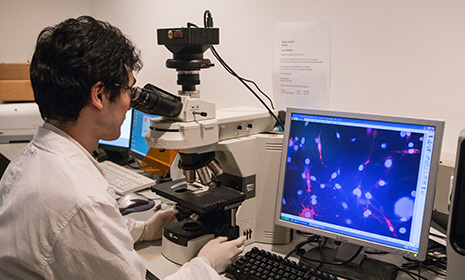HKU and international research teams find Middle East respiratory syndrome (MERS) coronavirus from dromedary camels in Egypt
An international research team, led by Professor Malik Peiris, Chair Professor of School of Public Health, Li Ka Shing Faculty of Medicine, The University of Hong Kong (HKU), in collaboration with the National Research Centre, Giza, Egypt and St Jude Children"s Research Hospital, Memphis, United States of America (USA), has found Middle East respiratory syndrome coronavirus (MERS-CoV) in dromedary camels in Egypt. The genome of camel MERS-CoV is almost identical to those found in human cases, which means dromedary camels can be a potential source of human infection. The research has been published this morning (February 28, 2014) in an international scientific journal, Emerging Infectious Disease.
Research Implications
Professor Malik Peiris, Tam Wah-Ching Professor in Medical Science and Chair Professor of School of Public Health, Li Ka Shing Faculty of Medicine, HKU, says, "The detection of MERS-CoV in camel in Egypt indicates that this virus exists in animals beyond the Arabian Peninsula and may possibly be causing human infections in a wider geographic region. The full genome sequence of the dromedary camel virus shows that it is very similar to the MERS-CoV detected in humans. Thus, the new findings, together with previous serological findings from our research team, and that of others, suggest that dromedary camels can be a potential source of human MERS-CoV infections."
The findings suggest the need for several measures: Firstly, a better surveillance of this virus is needed in animals, in particular in dromedary camels. Secondly, testing of patients with unexplained severe pneumonia for possible MERS-CoV infection should be done in a wider geographic region beyond the Arabian Peninsula, e.g. Egypt and Northeast Africa. Thirdly, tourists who go to the Middle East and Northeast Africa should be reminded of maintaining good personal hygiene when coming in contact with camels.
Study method and findings
Nasal swabs from apparently healthy dromedary camels (n=110; age >6 years) were collected in abattoirs in Egypt between June and December of 2013. Samples were tested for the genetic content of the MERS-CoV by real-time reverse transcriptase polymerase chain reactions (RT-PCRs). 4 out of 110 swab samples from dromedary camels were found to contain MERS-CoV sequences. The full genome of one of these viruses was fully characterised. The genomic sequence of the camel MERS-CoV is 99% similar to those found in human cases. Serological studies found that 48 out of 52 (92%) camel sera collected at the same geographical locations were positive for MERS-CoV antibodies indicating that past-infection is very common.
In contrast, sera from 179 persons working in dromedary camel abattoirs in Egypt were serologically negative for MERS-CoV, suggesting that transmission of this virus from camels to humans is an uncommon event. However, as the study proves that camels are carrying the MERS-CoV, there is still a significant risk for humans to acquire this virus from camels.
Background
MERS-CoV is a pneumonic illness caused by a novel coronavirus. From April 2012 to February 7, 2014, there have been 182 confirmed human cases leading to 79 deaths. All the primary human cases originated from countries within the Arabian Peninsula. The human virus is believed to be of zoonotic origin, but its natural reservoir remains an enigma. In the study, MERS-CoV is found in dromedary camels (Camelus dromedaries) which are the one-humped camels typically found in the Middle East and Northeast Africa as contrasted with Bactrian or two-humped camels (Camelus bactrianus) which inhabits Central Asia.
About the research team
This research was led by Professor Malik Peiris, Tam Wah-Ching Professor in Medical Science and Chair Professor of Virology, Acting Director of School of Public Health, Li Ka Shing Faculty of Medicine, HKU. Major team members from the School of Public Health in this study include Dr Daniel Chu, Post-doctoral Fellow, Dr Leo Poon, Associate Professor and Professor Yi Guan, Daniel CK Yu Professor in Virology. The international research team includes members from St Jude Children"s Research Hospital, Memphis, USA and National Research Centre, Giza, Egypt.









.png)
